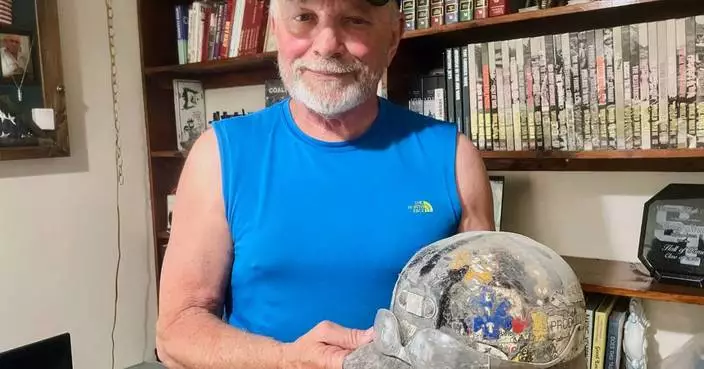BETHESDA, Md.--(BUSINESS WIRE)--Jul 8, 2024--
Sodexo, the nation’s largest federal foodservice contractor, proudly announces the company’s partnership with Chef Andre Rush, former White House chef for multiple administrations, bestselling author, award-winning Olympic chef, and U.S. veteran among other accolades. Through this partnership, Sodexo will benefit from Chef Rush’s culinary expertise alongside his special interest in supporting servicemen and women’s mental and physical well-being – to innovate and elevate menus across Sodexo’s government services.
This press release features multimedia. View the full release here: https://www.businesswire.com/news/home/20240708927354/en/
“One of my primary goals – and something that’s been evident in both my journey in the military and as a chef – is making a meaningful impact,” said Chef Andre Rush. “Sodexo proudly serves servicewomen and men across the U.S. as the largest federal foodservice contractor. I’m thrilled to lend my expertise to Sodexo, ultimately touching lives – and notably those serving our country – from coast to coast.”
Touting significant military and culinary achievements – including training over 10,000 troops in culinary arts and serving as a combat trainer, qualifying over 1,000 service members and civilians in hand-to-hand combat – Chef Rush is a devout advocate for veterans’ well-being. This led to the launch of his nonprofit, 2222 Inc., in tandem with his various culinary ventures.
“It’s a privilege to partner with Chef Andre Rush, a truly iconic chef blending culinary excellence with experience in military service. Chef Rush's dedication extends beyond meeting physical needs; he holds a profound passion for mental health and well-being, which is especially crucial for those in service,” said Brett Ladd, CEO, Government, Sodexo U.S. “The partnership between Sodexo and Chef Rush exemplifies a shared goal of making a meaningful impact.”
Sodexo serves 160 military and U.S. Federal Government locations in 28 states. With a commitment to improving Quality of Life and making a positive impact, Sodexo creates solutions for everything from dining and nutrition to facilities management and rehabilitative services for U.S. government and military organizations.
About Sodexo North America
Sodexo North America is part of a global Fortune 500 company with a presence in 45 countries. Sodexo specializes in sustainable food service and valued experiences, in all 50 U.S. states, Canada, Puerto Rico and Guam, at every moment in life: learn, work, heal and play. Additionally, the company indirectly supports additional jobs through its annual purchases of goods and services from small to large businesses. Sodexo North America is committed to meeting the challenges of everyday life with a dual goal: to improve the quality of life of our employees and those we serve, and contribute to the economic, social, and environmental progress in the communities where we operate. Our purpose is to create a better everyday for everyone to build a better life for all.


Sodexo Partners with White House Chef and Army Combat Trainer Andre Rush to Provide 27M Meals Annually to Servicewomen and Men Nationwide (Photo: Business Wire)
ANAHEIM, Calif. (AP) — José Ramírez hit three homers and carried the Guardians to a victory Friday night. The slugger claimed another place in Cleveland baseball history in the process.
Ramírez hit a solo homer in the first, a tying two-run shot in the fifth and another solo shot in the ninth inning of the Guardians' 8-6 victory over the Los Angeles Angels, ending Cleveland's three-game skid.
Ramírez's 26th career multi-homer game moved him even with Albert Belle and Jim Thome for the most multi-homer performances in the history of a franchise that began play in 1901. It was also the second three-homer game of Ramírez’s career, which has been spent entirely with Cleveland.
“I appreciate these types of days,” Ramírez said through an interpreter. “Sometimes it’s hard to hit one, and then when you hit three, you just thank God for these type of games, and most importantly because we won.”
Ramírez connected twice off Angels starter José Soriano, homering on two low breaking balls that looked quite similar — both on the way in to the plate and on the way out of right field.
He got his third off a high fastball from rookie Caden Dana, adding an insurance run that helped the Guardians to survive the Angels' two-run rally later in the ninth.
Ramírez also hit three homers on June 8, 2023, at home against Boston. His 259 homers are the second-most in Cleveland history, trailing only Thome's 337.
Ramírez's coaches and teammates could only marvel at another signature night from a superstar who doesn't always get his due.
“Best player in the world,” Cleveland manager Stephen Vogt said with a grin. “Man, he’s some kind of impressive. What a great night. Really picked us up on a night where we needed a lot of offense, and our best player came through the way those guys do. They step up. They know when we need that. They just have a knack for finding ways to do that. A three-homer game, those are so rare in itself, but to be able to witness it and to have him do it the way he did was really impressive.”
Ramírez did it six days after spraining his right wrist while sliding in Kansas City, a mishap that forced him to miss one game and has left him still missing a large chunk of skin on his hand.
The Guardians expect such feats from Ramírez, the six-time All-Star who made the All-MLB first team last season while leading Cleveland to 92 victories, the AL Central crown and the AL Championship Series. He led the Guardians in homers (39), RBIs (118) and stolen bases (41), barely missing the 40-40 club.
He hasn't stolen a base yet in 2025, but he's off to a strong start in the quest for his first 40-homer season.
“You always want good outcomes every time you hit,” Ramírez said. “Sometimes you hit the first homer, and then you don’t hit anything after that. We got good results.”
Ramírez's evening wasn't all good: He botched Luis Rengifo's two-out grounder to third in the third inning for his third error in three games. Jo Adell followed with a two-run single that put the Angels up 4-2.
Vogt said he isn't worried about Ramírez’s rough defensive stretch, calling it “a blip” for the third baseman who finished second in Gold Glove voting last year. The manager also knew Ramírez’s next at-bats would be important to him after an error.
“You always find with the top players in the league, when they happen to make a mistake like that, they seem to make up for it right away,” Vogt said. “It happens all the time. But we’re going to continue working on defense.”
AP MLB: https://apnews.com/MLB

Cleveland Guardians Jose Ramirez, center, celebrates with teammates after a baseball game against the Los Angeles Angels in Anaheim, Calif., Friday, April 4, 2025. (AP Photo/Eric Thayer)

Cleveland Guardians' Jose Ramirez celebrates with teammates in the dugout after hitting a home run during the fifth inning of a baseball game against the Los Angeles Angels in Anaheim, Calif., Friday, April 4, 2025. (AP Photo/Eric Thayer)

Cleveland Guardians Jose Ramirez, center, celebrates with teammates in the dugout after hitting a home run during the ninth inning of a baseball game against the Los Angeles Angels in Anaheim, Calif., Friday, April 4, 2025. (AP Photo/Eric Thayer)

Cleveland Guardians Jose Ramirez, left, celebrates with teammates in the dugout after hitting a home run during the ninth inning of a baseball game against the Los Angeles Angels in Anaheim, Calif., Friday, April 4, 2025. (AP Photo/Eric Thayer)

Cleveland Guardians third baseman Jose Ramirez runs the bases after hitting a home run during the first inning of a baseball game against the Los Angeles Angels in Anaheim, Calif., Friday, April 4, 2025. (AP Photo/Eric Thayer)























































